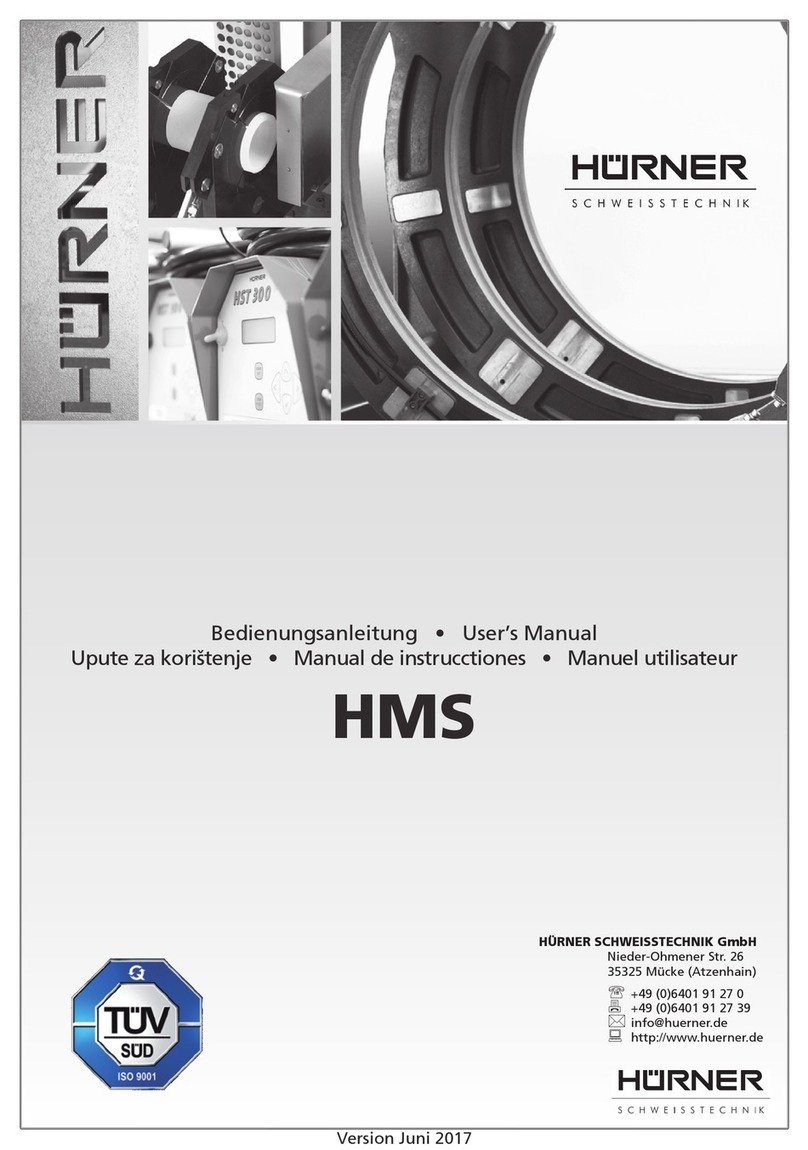
Version April 2012
8 DE Bedienungsanleitung HÜRNER HST – S – 315
HÜRNER Schweißtechnik GmbH
Nieder-Ohmener Str. 26
35325 Mücke,
Deutschland
nung) der Muffe entsprechen (Hersteller und Durchmesser), die
verschweißt werden soll.
Die Nichtbeachtung dieser Anweisung führt zu nicht ordnungs-
gemäßer Schweißung, kann Schäden am Schweißautomaten nach
sichziehenundführtinjedemFallzumErlöschenderGewähr-
leistung für den Automaten. Es gelten folgende Zuordnungen
Anschlusstyp A00 – gelber Stecker —— Muffe mit Durchmesser
32 - 160 mm, Hersteller Valsir, Akatherm, Eurofusion, Geberit,
Waviduo, Coes
Anschlusstyp A01 – blauer Stecker —— Muffe mit Durchmesser
200 - 315 mm, Hersteller Valsir, Akatherm, Eurofusion, Wavisolo
Anschlusstyp A02 – roter Stecker —— Muffe mit Durchmesser
200 - 315 mm, Hersteller Geberit
Anschlusstyp A04 – weißer Stecker —— Muffe mit Durchmesser
200 - 315 mm, Hersteller Coes
Die Schweißkontakte sind mit der Muffe zu verbinden, und es ist auf festen
Sitzzuachten.DieKontaktächenderSchweißkontakteundderMuffe
müssen sauber sein. Verschmutzte Kontakte führen zu Fehlschweißungen,
außerdem zu Überhitzung und Verschmorung des Anschlusssteckers.
Nach dem Anschluss des Schweißkabels an den Schweißautomaten zeigt
das Display den Anschlusstyp, A00, A01 usw. Sobald das Kabel an die zu
verschweißende Elektroschweißmuffe angesteckt ist, leuchtet die gelbe
LED (Fitting angeschlossen) auf. Beim Anschlusstyp A04 (weißer Stecker)
erscheint dann zusätzlich im Display der Durchmesser der kontaktierten
Coes-Muffe:200mm,250mmoder315mm.
NachdemKontaktierendesElektroschweißttingswirddieSchweißung
durch Betätigen der START-Taste begonnen. Beim Schweißstart wird die
SchweißzeitangezeigtunddannalsCountdownheruntergezählt.
Die Schweißzeit kann je nach verarbeiteter Muffe bis zu 700 s sein; sie wird
auf der Anzeige rückwärts gezählt.
5.3 Schweißprozess
Der Schweißprozess wird während der gesamten Schweißzeit nach den
errechneten Schweißparametern der Schweißmuffe überwacht.
5.4 Ende des Schweißprozesses
Der Schweißprozess ist ordnungsgemäß beendet, wenn die Ist-Schweißzeit
0 s beträgt (Anzeige 000),gleichzeitig die grüne LED (Ende)aueuch-
tetunddasakustische Signalzweimalertönt.Davonabweichendstellt
beim Anschlusstyp A02 das System das korrekte Schweißende selbsttätig
fest, und trotz Anzeige 000 kann das Schweißen fehlerhaft sein (vgl. Ab-
schn. 6.11).
5.5 Abbruch des Schweißprozesses
DerSchweißprozessistfehlerhaft,wenndieroteLED(Störung)leuchtet
unddasakustischeSignalimIntervalltonertönt.WeiterhinwirdeinFeh-
lercode auf der Anzeige dargestellt.
Ein Fehler lässt sich nur mit der STOP-Taste quittieren.
5.6 Abkühlzeit
Die Abkühlzeit ist nach den Angaben des Fittinghersteller einzuhalten. Zu
beachten ist, dass während dieser Zeit keine äußeren Kräfte auf die noch
warmeRohr-Schweißtting-Verbindungwirkendürfen.





























